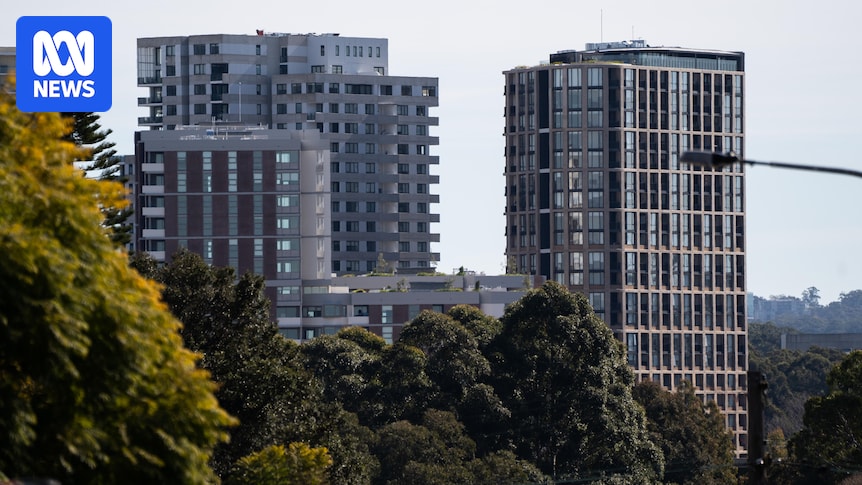High construction costs and labour shortages is causing approvals for new dwellings to fall across Australia, according to housing experts.
Data released by the Australian Bureau of Statistics (ABS) showed house and apartment approvals in August fell 6.1 per cent to 13,991 compared with July.
The ABS said the result was driven by a 16.5 per cent drop in approvals for middle to high density homes, such as apartments and units.
CoreLogic head of research Tim Lawless told the ABC that approvals for multi-unit developments was about 18 per cent below average.
Australian Bureau of Statistics data shows 13,991 approvals were granted in August. (ABC News: Keana Naughton)
Mr Lawless said apartment building construction was becoming increasingly costly for developers and builders.
He said a tight labour market, competition with big construction projects and costly building materials often made it unfeasible for developers to build.
Tim Lawless says construction was becoming increasingly costly for builders. (Supplied)
“Construction costs have risen by more than 30 per cent over the past four to five years, so that in itself has really compressed profit margins,” he said.
“Labour markets for building trades are extraordinarily tight … and there’s also a lot of competition with the non-residential sector.”
The data showed approvals for detached homes have risen by 0.5 per cent, but Mr Lawless said that increase was still “sluggish”.
“At the moment we’re seeing total dwelling approvals that are tracking at 13,000 to 14,000 a month … so we’re nowhere near that run rate target [of 20,000].”
‘Stable’ picture overall despite falling home approvals
University of Sydney professor of urban regional planning Nicole Gurran said there’s often no urgency to put high density buildings forward for approval because of their complexity.
Professor Nicole Gurran says single households are much less complex to build. (Supplied: Nicole Gurran)
“Single households are much less complex and of course the building sites are less complicated as well [and] much less risky than when you’re talking about the complex in a city,” Professor Gurran said.
In November 2017, Australia approved 23,033 dwellings — the highest number of approvals in a single month since August 2009, according to the ABS data.
However, that number reached a decade-low in January 2023 when the number of approvals fell to 12,205.
Mr Lawless said construction was “cyclical” and that the fluctuation in approvals has often been influenced by big multi-unit projects.
“It was a cycle that was really influenced by a large amount of high-rise construction, particularly in Sydney, Melbourne and Brisbane,” he said.
“I think trying to compare that period of time to now is very different because construction costs were a lot lower, profitability was quite strong.”
Data shows approvals for free-standing homes rose by 0.5 per cent. (ABC News: Keana Naughton)
Australian Housing and Urban Research Institute managing director Michael Fotheringham said that having a steady pipeline of projects also contributed to approval numbers.
Dr Fotheringham said the reason approvals may be low was because builders already have land that has been approved for development and were waiting to build on it.
“For some of those properties, the feasibility of that development is not what it was when they first purchased the land because costs have gone up,” he said.
“That can mean the need to go back for a new approval for a higher value development on that site.”
However, Dr Fotheringham said while the data showed approvals have been lower in previous years, they have remained overall mostly stable.
“We shouldn’t get too caught up in sort of little wiggles in the data. It is a relatively stable picture overall,” he said.
“But the truth is we’re not going gangbusters building at the moment and while I think everyone agrees we would like to be, the costs are making that really difficult.”
Social housing could alleviate supply issues amid low approvals
Dr Fotheringham said the broader economic situation needed to improve and prices needed to remain stable enough for dwelling approvals to pick up again.
“We need people to be confident, we need people to actually borrow enough to build and we need developers to be confident the prices are stable enough,” he said.
“The heightened costs we have, particularly around material supply and workforce at the moment, are system challenges that need to be addressed over time.”
Experts say social housing could help alleviate pressure on the private sector. (ABC News: Brant Cumming)
Professor Gurran said government land developers can play a big role in de-risking sites to moderate the market and make sure there was an ongoing moderately priced supply of land for development.
The federal government has committed to building 1.2 million new homes over five years from July under its National Housing Accord.
But Professor Gurrann said governments should invest more in social and affordable housing.
“Their ability to make sure that there’s always this pipeline of moderately priced land is being curtailed,” she said.
“All the way up until the mid-1990s more than 10 per cent of new homes delivered were being funded by the public sector, delivered by the public sector.
“That’s a significant underwriting of supply that helps make sure the housing industry is able to build consistently, respective of what the market is doing.”
Mr Lawless from CoreLogic agreed and said governments could step in to provide more social and affordable housing.
“Government-owned housing is a very small component of the marketplace but arguably the government would be better placed to deliver stocks in a marketplace that isn’t reliant on a profit margin,” he said.
In the meantime, he said governments could support private builders by covering the cost of delivering essential services such as sewerage, telecommunications and roads which can be costly.
